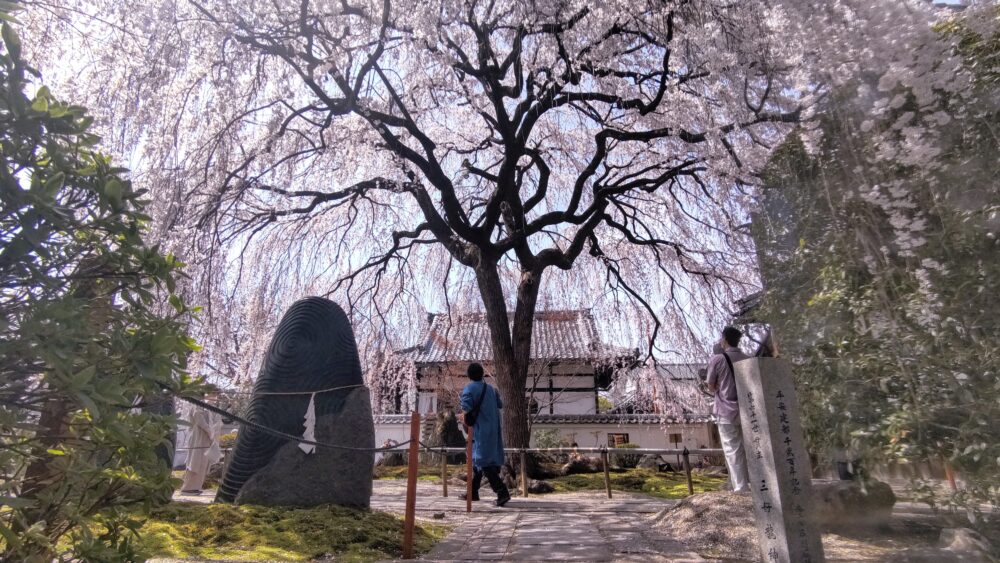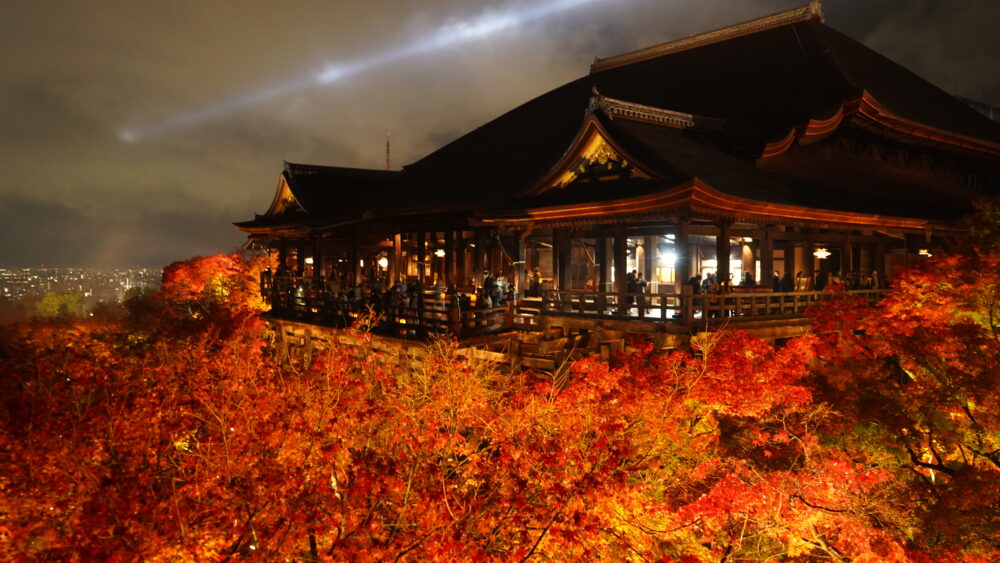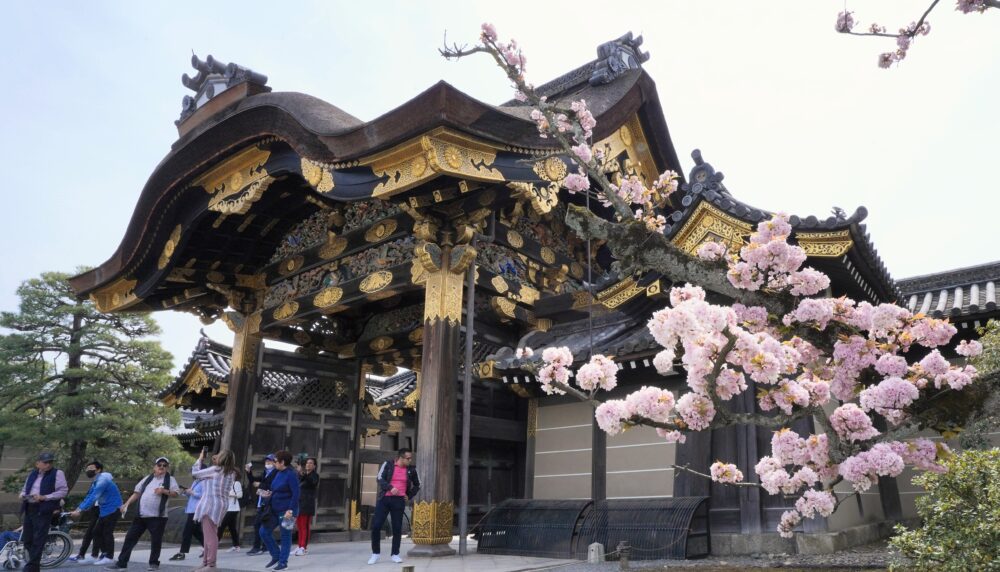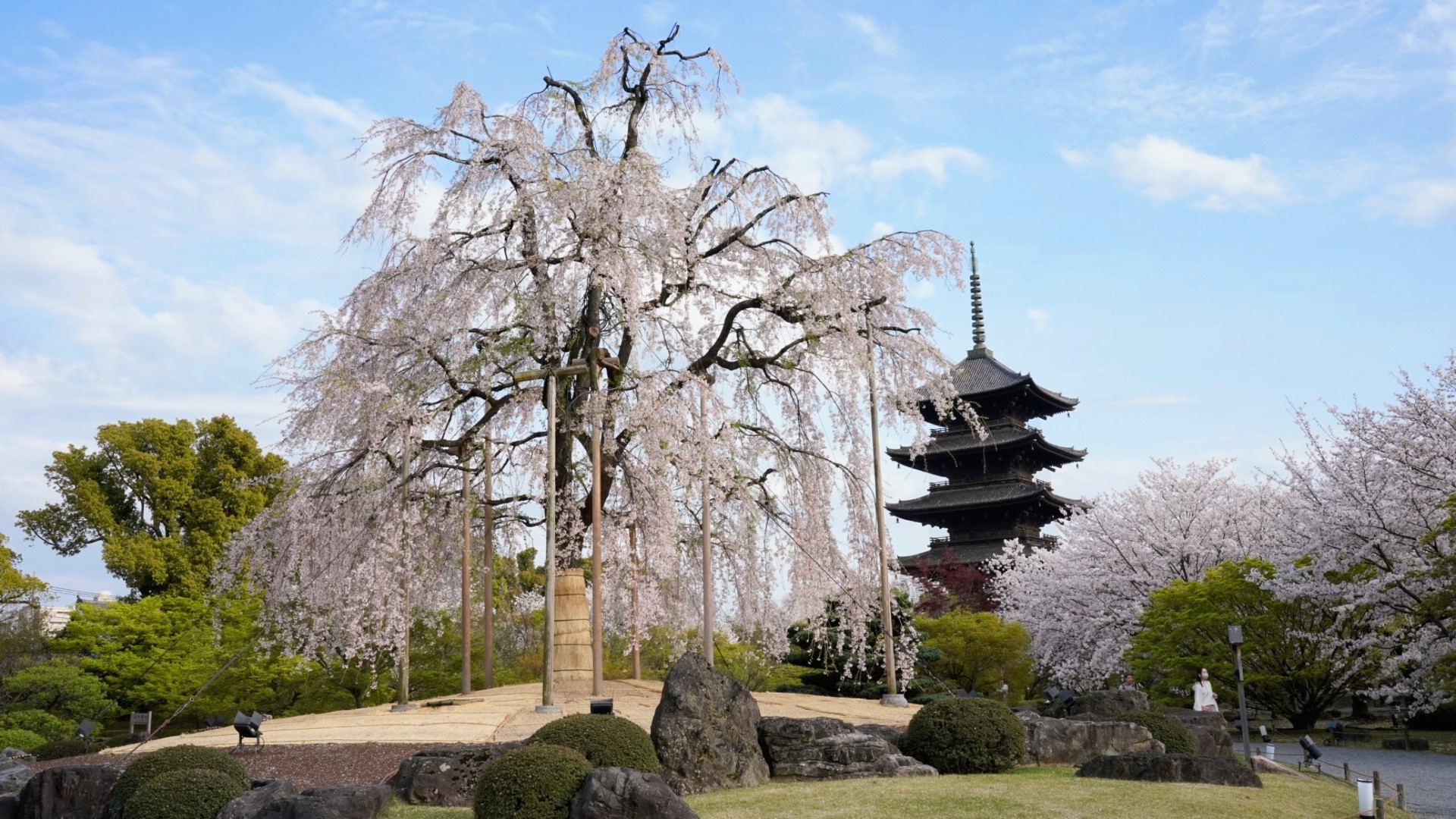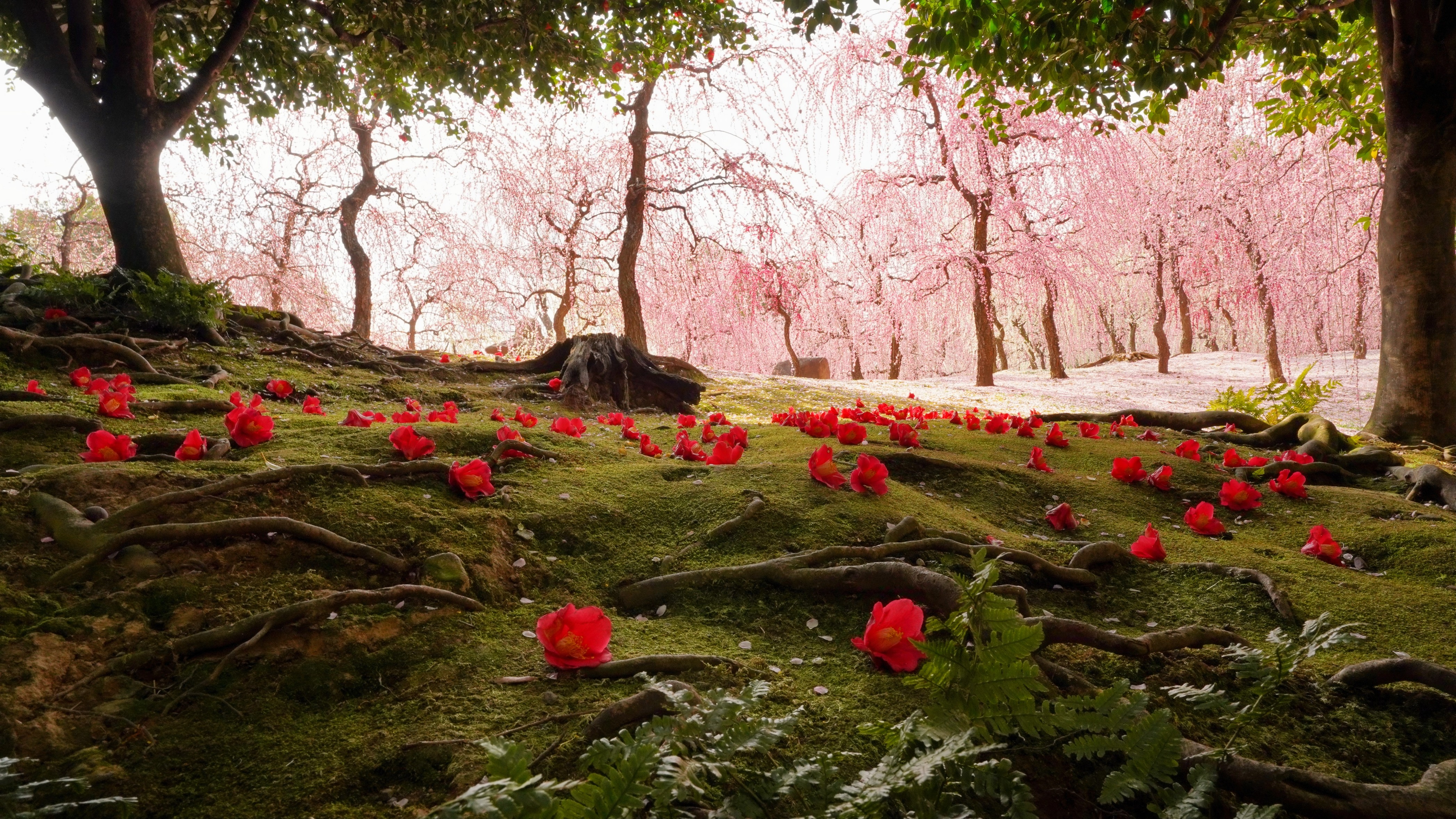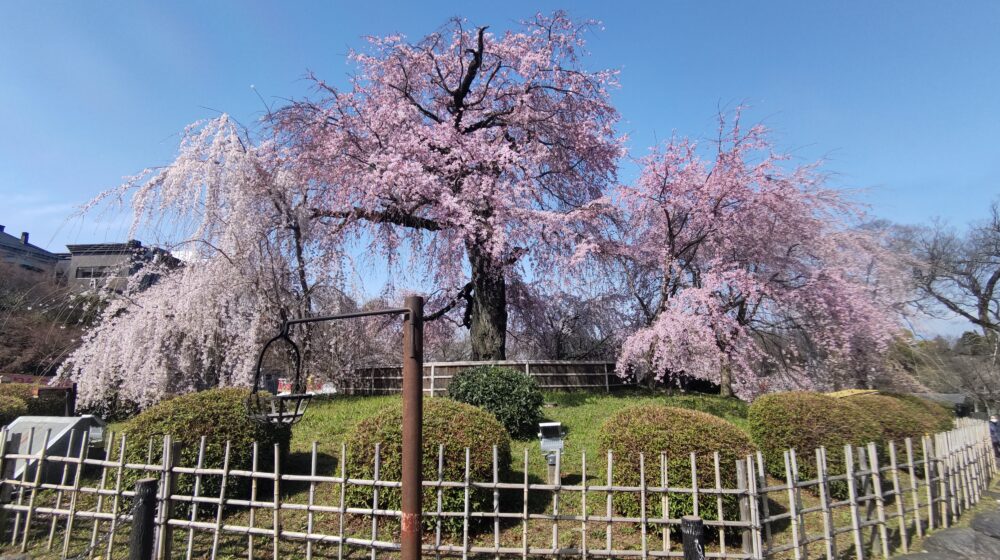Kyoto’s Spring illumination in 2025 : 10Best Spots and Tips to avoid crowds
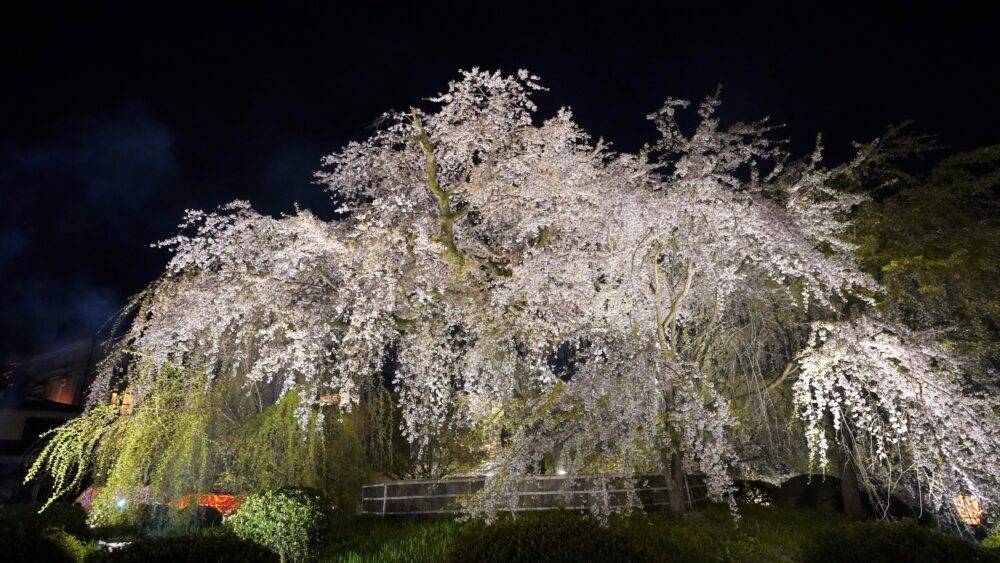
The spring illuminations during cherry blossom season(early March to early April) is a highly popular. A truly magical experience that combines the delicate beauty of the cherry blossoms with the soft glow of lights, creating an ethereal and unforgettable atmosphere.
If you want to know the exact cherry blossom blooming period, the Somei Yoshino cherry blossom (the most popular hybrid cherry blossom in Kyoto, with more than tens of thousands of trees planted in gardens and streets) blooming forecast is published on the following website.
https://n-kishou.com/corp/news-contents/sakura/?lang=en
However, even at night during the high season, popular spots are crowded with tourists, and it can take a long time just to get to your destination. To avoid the congestion, it is crucial to plan and prepare beforehand. Here are 9 Must-See Cherry Blossom Night Illumination Spots in 2025 and tips to avoid crowds.
Toji Temple
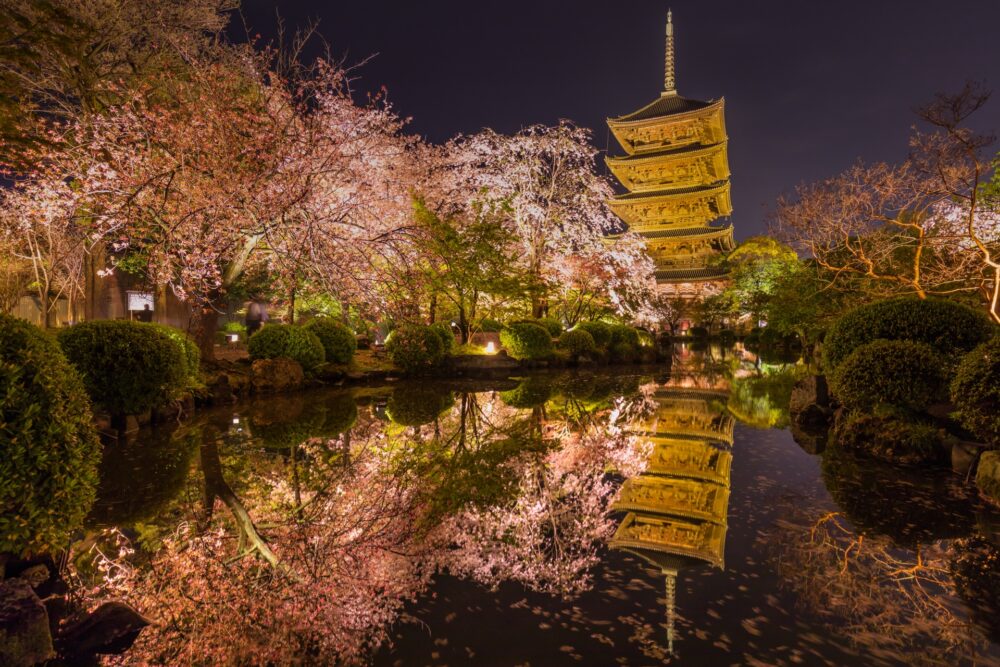
Todai-ji Temple, located in the heart of Kyoto, just a 15-minute walk from Kyoto Station, is the head temple of the Shingon sect of Buddhism and boasts a rich history dating back over 1,200 years.
The highlight of the temple’s cherry blossom season is the stunning sight of its 179ft(54.6m)-tall wooden five-storied pagoda illuminated against a backdrop of vibrant pink blossoms. The reflection of the pagoda and the cherry trees in the temple’s pond creates a mesmerizing that is truly a sight to behold. The north side of the Hyotan Pond (a gourd-shaped pond) in garden is a great spot to take photos of the Somei Yoshino cherry trees and the Five-Storied Pagoda reflected in the water.
In addition to the reflected views , Todai-ji Temple is also known for its beautiful weeping cherry blossom of the Yae Benishidare variety, known as Fuji zakura, named after the Kukai’s teaching of Fuji that all beings are fundamentally interconnected and that there is no separation between the self and others. This is weeping cherry tree producing pink blossoms with 15 or more petals. This stunning tree, measuring 43ft(13m) tall and 32ft(10m) wide, is one of the largest weeping cherry trees in Japan.
There are also feature approximately 200 other cherry trees of various varieties, which bloom from early to late spring, offering visitors a prolonged period of enjoyment.
Tips to avoid crowds
- Visit late at night
For a quieter visit, try going to the temple around 8:30pm, an hour before closing time. This way, you can enjoy the peaceful atmosphere of the temple and its gardens without having to deal with the crowds that usually come during peak hours. - Visit on weekdays
Weekends tend to be busier, so visiting on a weekday can help you avoid the crowds and have a more relaxed time exploring the temple. - Avoid traveling by car or bus
During the illumination period, roads are congested, so it is best to avoid buses and taxis. Instead, I recommend walking, which takes about 15-minutes from Kyoto Station to Toji Temple West gate(Reception).
Information
・Special night viewing
Spring season( Mar 15th to April 13th)
| Place | Time | Price |
|---|---|---|
| Kondo and Kodo | 6:00pm – 9:30pm( Last Entry is at 9:00pm) | ・Adult: 1,000 yen ・Junior high school student and younger : 500 yen |
※Temple is closed during after day time and before night time(5:00pm – 6:00pm)
Cannot be used as a Special night viewing ticket
・Day time
Open hours
All season : Read more…
| Place | time |
|---|---|
| ・Kondo(Main hall) ・Kodo(Lecture hall) ・Five-storied pagoda first floor | 8:00am – 5:00pm( the reception close at 4:30pm) |
| Kanchi-in(Sub-temple) and Homotu-in(Museum) (Mar 20th to Apr 26th) | 9:00am – 5:00pm( the reception close at 4:30pm) |
Entrance fee
Winter season(Jan 10th to Mar 18th) : Read more
| Place | Price |
|---|---|
| Five-storied pagoda first floor, Kondo and Kodo | ・Adult: 800yen ・High school students : 700yen ・Junior high school students and younger: 500yen |
| Kanchi-in | ・Adult: 500yen ・Junior high school students and younger: 300yen |
| Homotu-kan | ・Adult: 500yen ・Junior high school students and younger: 300yen |
| All Places | ・Adult: 1,300yen ・Junior high school students and younger: 800yen |
Normal season(Mar 19th) : Read more
| Place | Price |
|---|---|
| Kondo and Kodo | ・Adult: 500yen ・High school students : 400yen ・Junior high school students and younger: 300yen |
| Kanchi-in | ・Adult: 500yen ・Junior high school students and younger: 300yen |
| All Places | ・Adult: 800yen ・Junior high school students and younger: 500yen |
Spring season(Mar 20th to April 26th) : Read more
| Place | Price |
|---|---|
| Kondo and Kodo | ・Adult: 500yen ・High school students : 400yen ・Junior high school students and younger: 300yen |
| Kanchi-in | ・Adult: 500yen ・Junior high school students and younger: 300yen |
| Homotu-kan | ・Adult: 500yen ・Junior high school students and younger: 300yen |
| All Places | ・Adult: 1,000yen ・Junior high school students and younger: 500yen |
Adress
1 Kujocho, Minami Ward, Kyoto, 601-8473
How to get Toji temple
- It’s 15-minutes walking from Kyoto Station to Toji Keigamon entrance gate(East)
- Nearest bas stop is Toji higashimon mae
Official cite
Toji Temple(English)
Nijo-jo Castle
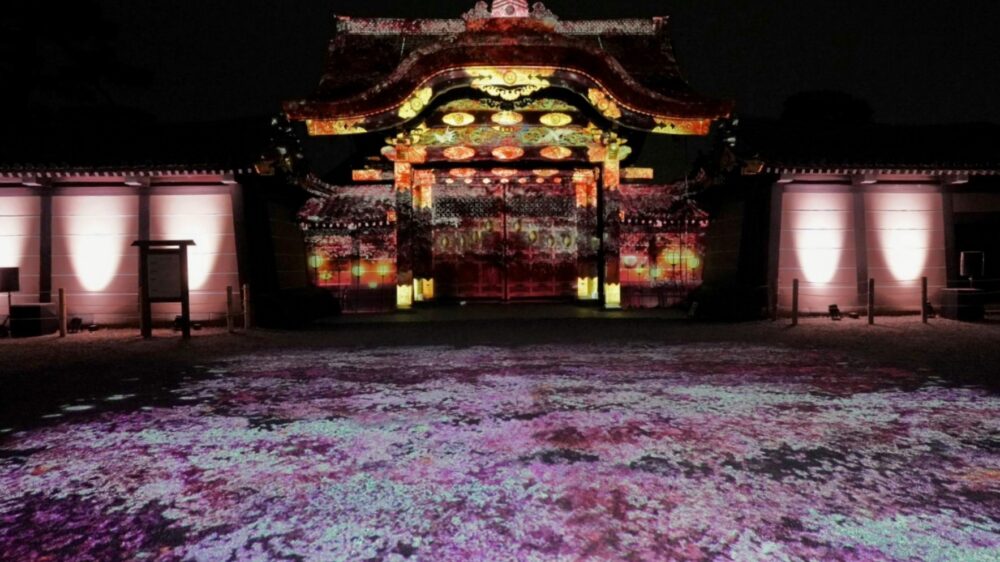
Nijo-jo Castle is a UNESCO World Heritage Site and one of the most iconic landmarks in Kyoto, Japan. This castle was built in 1603 by Tokugawa Ieyasu, the first shogun of the Edo period, as his Kyoto residence and a place to protect the emperor.
Nijo-jo Castle is especially popular in cherry blossom season. This castle has approximately 300 cherry trees of 50 different varieties, ranging from early to late bloomers. This means that visitors can enjoy cherry blossoms at Nijo-jo Castle for an extended period of time, from mid-March to early April.
During the night event, Karamon Gate, which is the castle’s magnificent gilded second entrance gate is transformed into a canvas for a breathtaking projection mapping show. The gate displays vibrant cherry blossom patterns, creating a truly magical spectacle. White walls of Nijo Castle and white stucco walls of Kura (storehouse) are also illuminated with projection mapping, and the sight of the beautiful cherry blossoms in full bloom is breathtaking.
During the night light-up, there are food stalls, souvenir shops, and flower arrangement exhibitions. lantern rentals available inside Nijo Castle, and events are held to enjoy the spring night in Kyoto.
Tips to avoid crowds
- Reserve the tickets
During peak times, visitors have to wait in line for more than 30 minutes to buy tickets at the reception desk. I highly recommend purchasing your tickets online in advance.
Ticket booking site
Sakura Festival 2025 Ticket at Nijo-jo Castle
- Visit on weekdays
It is expected to be crowded on weekends and public holidays (March 20th), so if possible, it is recommended to visit on weekdays. - Visit late at night
The castle is open for night viewing from 6:00pm to 10:00pm, with the last entry at 9:00pm. The crowds tend to be smaller after 8:30pm - Avoid traveling by car or bus
The night illumination period (March 8th to April 7th) is considered the peak season to see cherry blossoms, and the roads can be congested during this time. To avoid traffic, it is recommended to walk or take the train instead of buses or taxis.
The nearest station is Nijojo-mae Station on the Tozai Subway Line. It is a 5-minute walk from the East entrance gate
Directions from Kyoto Station: Take the Karasuma Subway Line from Kyoto Station to Karasuma-Oike Station. Transfer to the Tozai Subway Line and get off at Nijojo-mae Station.
Information
Night illumination
Open hours
| Place | Period | Time |
|---|---|---|
| Nijo-jo castle | March 14th – April 13th | 6:00pm – 10:00pm(Last Entry is at 9:00pm) |
Entrance fee
| Day | Reservation |
|---|---|
| Monday – Thursday | Junior high school student and above : 2,000 Yen Junior school : 1,200 Yen |
| Friday – Sunday and Holiday(March 20th) | Junior high school students and above : 2,400 Yen Junior school : 1,600 Yen |
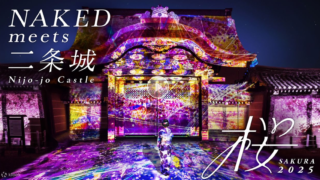
Day time
Open hours : Read more…
| Place | Time |
|---|---|
| Nijo-jo castle | 8:45am – 5:00pm(the reception close at 4:00pm) |
| Nijo-jo Castle and Ninomaru-goten Palace | 8:45am – 4:10pm |
Entrance fee : Read more…
| Place | Price |
|---|---|
| Nijo-jo castle | Adult : 800yen Junior high school : 400yen Elementary school : 300yen |
| Nijo-jo Castle and Ninomaru-goten Palace | Adult : 1,300yen Junior high school : 400yen Elementary school : 300yen |
Regular holiday
・Nijo-jo castle
December 29th to 31st
・Ninomaru-goten Palace
Every Tuesday in January, July, August, and December
January 1st to 3rd, and December 26th to 28th
*When any of the above-mentioned days fall on a public holiday, Ninomaru-goten Palace will be closed the next day instead.
*Entrance fee is free for children younger than elementary school age.
Adress
541 Nijojocho, Nakagyo Ward, Kyoto, 604-8301
Official website
Nijo-jo Castle(English)
Maruyama Park

Maruyama Park is renowned as the most popular cherry blossom viewing spot in Kyoto. This park was established in 1886, the park boasts approximately 700 cherry trees of various varieties, including weeping cherry trees, Somei Yoshino cherry trees, and Yae cherry trees, visitors can enjoy for a long period of time.
The highlight is Hitoe Shiro Higan Shidare-Zakura, which a type of weeping cherry blossom with five white petals and variety of the Edo Higan cherry blossom. This weeping cherry tree is located at the center of the park. Standing tall at 39ft(12m), this magnificent tree is flanked by two other cherry trees, creating the illusion of a single, colossal cherry tree. During the night event, torches are placed around the cherry trees, creating a dreamlike atmosphere.
Additionally, there are the “Hanami Chaya” (tea house) in Maruyama park.Visitors can order food and enjoy a unique “Hanami” experience while seated on benches adorned with vermilion felt carpets, surrounded by the enchanting beauty of the cherry blossoms. This special moment of savoring delicacies under the cherry blossoms is truly unparalleled.
Tips to avoid crowds
- Visit late at night
The center of Maruyama Park is crowded with people to see the weeping cherry tree. However, if you go at 9:00pm, one hour before the illumination ends, there will be fewer people and you can see the weeping cherry tree. - Visit on weekdays
On weekends, Japanese tourists also visit, so it is better to visit on weekdays if possible. - Avoid traveling by car or bus
During the cherry blossom season, the roads in Kyoto are congested with cars, so it is not recommended to travel by bus or taxi. Instead, it is better to take a bus and walk to Maruyama Park. It’s 9 minute walk away from nearest station: Hankyu-Kyoto Line “Kyoto-Kawaramachi” station to Maruyama Park
Information
Open hours
Open 24hours
Night illumination
From sunset to 10:00pm
Admission
Free
Address
Maruyamacho, Higashiyama Ward, Kyoto 605-0071
Official site
Maruyama Park(Only Japanese text)
Kiyomizu-dera temple
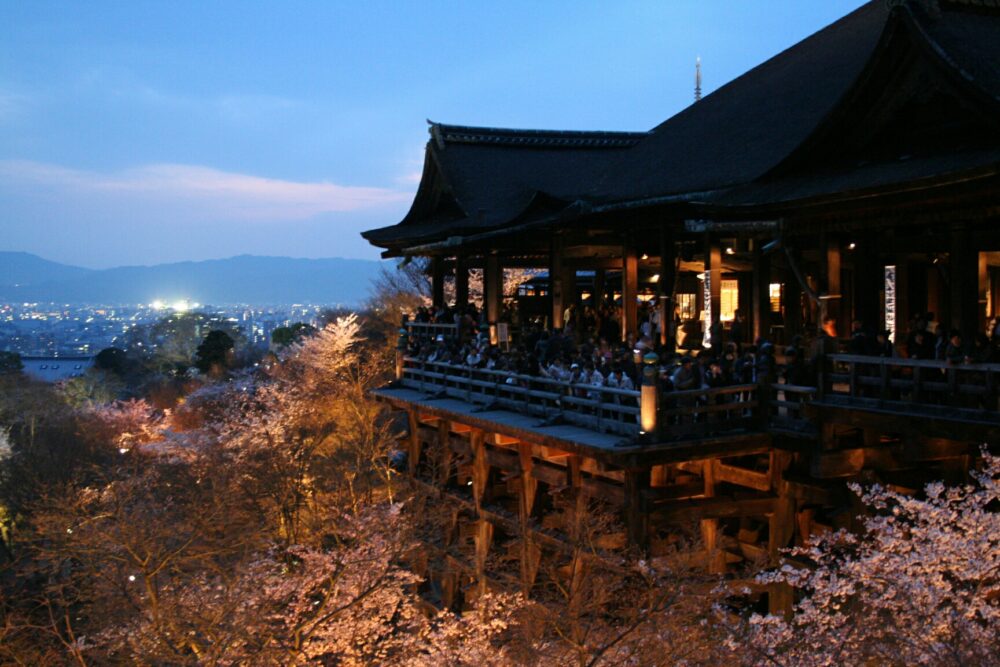
The world-famous Kiyomizu-dera Temple is also renowned as a spectacular cherry blossom night viewing spot, with approximately 1,500 cherry trees of various types, including Somei Yoshino and Yama Zakura, blooming with pale pink flowers that bloom with reddish leaves, adorning its grounds. While the temple’s iconic wooden stage is a popular attraction, the surrounding area also boasts a mesmerizing display of Somei Yoshino cherry trees.
The Somei Yoshino, the most popular cherry blossom variety in Japan, is known for its synchronized blooming, as all trees of this cultivar share the same genetic makeup. This results in a breathtaking sight at Kiyomizu-dera Temple, where the stage is enveloped in a vibrant sea of pink blossoms.
Moreover the enchantment, the temple’s other cultural landmarks, such as the 101ft(31m)-tall three-storied pagoda and the Niomon Gate, which enshrines the temple’s guardian deities carved by Unkei and Kaikei, are illuminated during this period, creating an gorgeous visual spectacle.
In addition to Kiyomizu-dera Temple, Higashiyama Ward has many famous night viewing spots, and tourists often visit these nearby spots together. For example, Yasaka Shrine, famous for its giant vermilion torii gate and Somei Yoshino cherry blossoms; Maruyama Park, famous for its giant weeping cherry blossoms and light-up; and Kodai-ji Temple, famous for its weeping cherry blossoms and dry landscape garden.
Gion district, where traditional teahouses offer geisha performances and where you can enjoy the traditional cityscape, is also nearby, and many tourists visit.
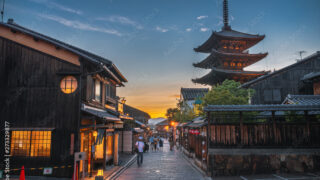
Tips to avoid crowds
- Visit on weekdays
on weekends and public holidays in Japan, the temple is thronged with Japanese tourists, so it is recommended to visit on weekdays if possible. - Visit late at night
it is best to arrive at 8:30pm, 30 minutes before the reception closes. - Avoid traveling by car or bus
During the cherry blossom season, all roads around Kiyomizu-dera Temple are congested with cars, so it is recommended to walk from the nearest stations, Kiyomizu-Gojo Station or Kawaramachi Station. - The three streets leading to Kiyomizu-dera Temple: Ninenzaka, Sannen-zaka, and Gojo-zaka, are all crowded.
Information
Special night viewing time
Spring season (March.25th – April.3rd)
| Time | Entrance fee |
|---|---|
| 6:30pm – 9:30pm (Last Entry is at 9:00pm) | Adult : 400yen Elementary school and Joiner high school student : 200yen |
Day time
Open hours and Entrance fee : Read more
| Period | Time | Entrance fee |
|---|---|---|
| Normal | 6:00am – 6:00pm | Adult : 400yen Elementary school and Joiner high school student : 200yen |
| Summer season (July 1st – August 31st) | 6:00am – 6:30pm |
*Temple is closed during after day time and before night time(5:30pm – 6:30pm)
Address
1 Chome-294 Kiyomizu, Higashiyama Ward, Kyoto, 605-0862
Official site
Kiyomizu-dera Temple(English text)
Kodaiji Temple
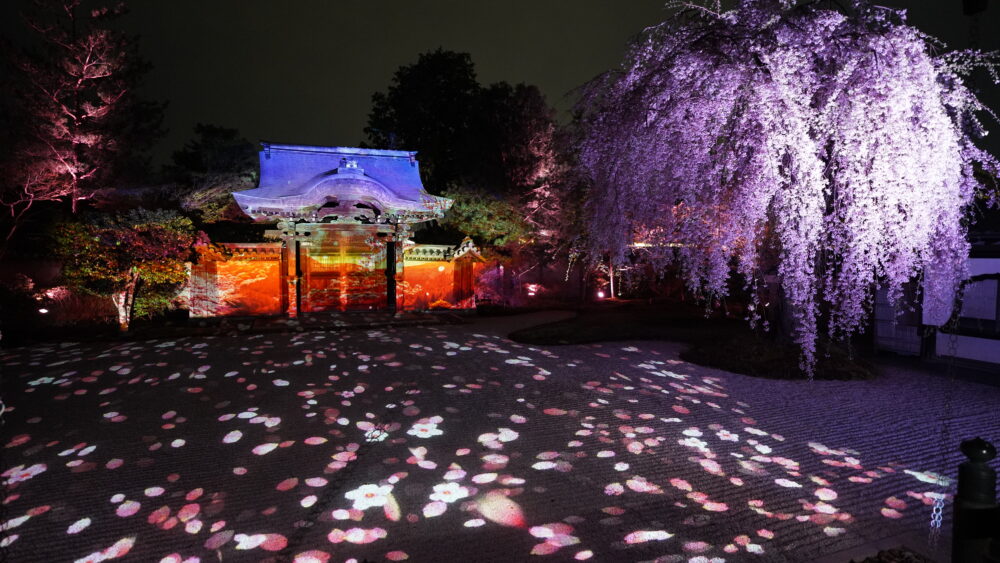
Kodaiji Temple, a Rinzai Zen temple in Kyoto, was built by Nene to honor her husband, Toyotomi Hideyoshi in 1606. The temple features historical buildings like the Kaisando Hall and the Otamayama mausoleum, beautiful gardens and tea houses where visitors can experience a traditional tea ceremony.
In late March, Benishidare-zakura(weeping cherry trees) in the Japanese dry garden next to Hojo hall will be in full bloom, adorned with gorgeous pink petals. At night, the illumination event will light up these cherry trees, creating a magical sight. The bamboo cave leading up to the temple will also be lit up, highlighting the lush green of the bamboo.
Tips to avoid crowds
- Visit on Weekdays
Not only foreign tourists but also many Japanese also visit on weekends and holidays, so it is better to go on a weekday if possible. - Late-night visit
Enter around 8:00 pm, one hour before the temple closes.This will allow you to see the cherry blossoms without having to worry about the crowds. - Use trains and walk
The roads may be congested with cars, so taking the train and walking is the best way to get there on time. The nearest station is Kawaramachi Station on the Hankyu Line, and it is an 18-minute walk from Kodaiji temple.
Incidentally, Higashiyama Ward, where Kodaiji Temple is located, is home to many cherry blossom spots such as Kiyomizu-dera Temple, Maruyama Park, and Yasaka Shrine. If you are visiting Kodaiji Temple, I recommend visiting these places as well.
Information
Night illumination
(March.14th to May.6th)
Open hours
5:00pm to 10:00pm(Last entry is at 9:30pm)
Entrance fee
| Kodaiji temple | Adult : 600yen High school and Joiner high school student : 250yen |
| Kodaiji temple and Entokuin temple | Adult : 900yen |
Day Time
Read more…
Open hours
9:00am – 5:30pm(Reception close at 5:00pm)
Entrance fee
| Kodaiji temple | Adult : 600yen High school and Joiner high school student : 250yen |
| Kodaiji temple and Entokuin temple | Adult : 900yen |
Address
〒605-0825 Kyoto, Higashiyama Ward, Kodaiji526
Kodaiji Temple(English text)
Chion-in Temple
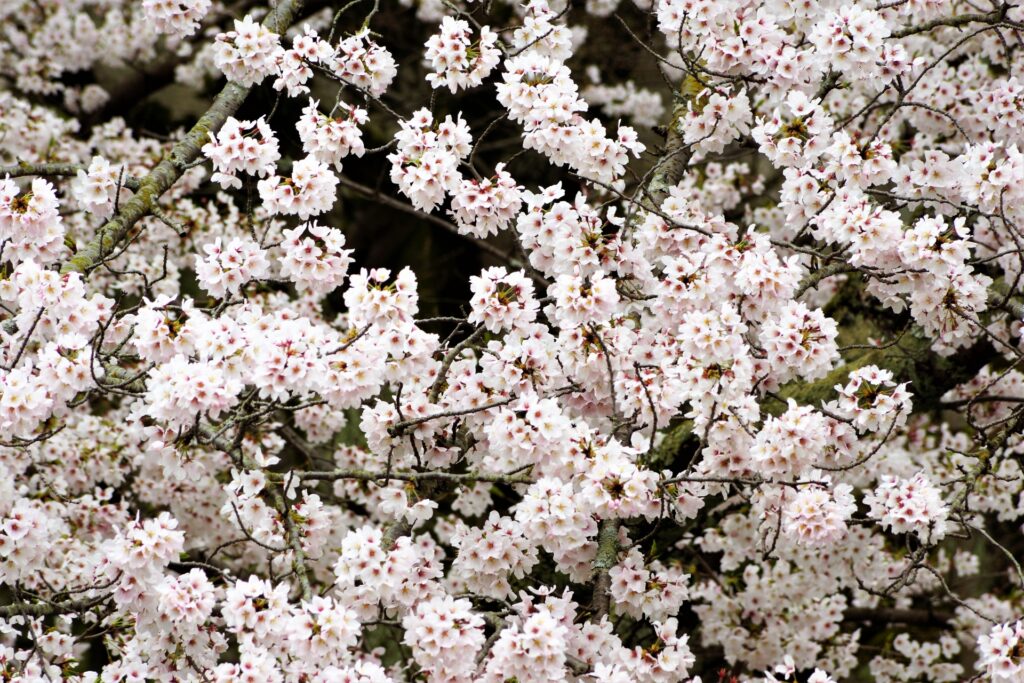
Chion-in Temple, located in the same Higashiyama area as Kiyomizu-dera Temple and Maruyama Park, was founded in 1175 by Honen, the founder of the Jodo sect of Buddhism, who built a hermitage there and began preaching the teachings of Nenbutsu. After Honen’s death in 1212, his disciples built a mausoleum. Today it is the main temple of the Jodo sect. It is famous for its cherry blossoms, and you can see rows of cherry trees over a wide area from Mt. Kacho in Higashiyama to Higashioji Street. You can also enjoy the magnificent cherry blossoms around the huge 24-meter-high National Treasure Sanmon Gate, as well as in the Yuzen-en Garden and the Mausoleum.
At night, the temple is lit up, and the National Treasure Sanmon Gate, the Otoko-zaka slope that you pass through, and the Yuzen-en Garden all glow with the cherry blossoms.
Tips to avoid crowdes
- Visit on a weekday instead of a weekend;
the temple is more crowded on weekends and holidays, as Japanese tourists also visit - Visit earlier than other sightseeing spots in the Higashiyama area;
Due to its proximity to Kiyomizu-dera Temple and Maruyama Park, which are also illuminated, Chion-in is very crowded with tourists as part of their sightseeing route. Since the illumination starts at 5:45 p.m., which is earlier than other places, it is recommended to visit Chion-in first. - Take the train and walk;
During the spring cherry blossom season, the temple is crowded with tourists. It is better to take the train and walk than to take a car or bus.it’s 15minitue-walking from nearest train station “Kwaramachi station to Chion-in temple
Information
Special night viewing
Open hours
| Period | Time |
|---|---|
| March,26th – April,6th | 5:45 p.m. – 9:30 p.m. |
Places
Uzen-en Garden, Sanmon Gate, Mieido Hall, Onna-zaka Slope, Amida-do Hall (entry prohibited)
Price
Adults: 800yen, Children(elementaly, junior high chool): 400yen
Adress
400 Rinkacho, Higashiyama Ward, Kyoto, 605-8686
Official Website
Chion-in(English text)
Heian Jingu shrine
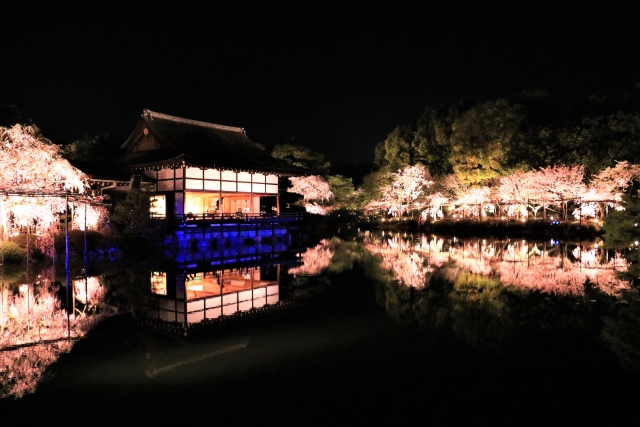
The Heian Jingu Shrine is a Shinto shrine located in the northeast of Kyoto and is one of the most representative shrines in the city. It was built in 1895 to commemorate the 1100th anniversary of Kyoto’s founding as the capital of Japan during the Heian period.
The main building of the shrine, painted in vermilion, is a replica of the Heian period imperial palace, built at a scale of 8/5 of the original. The shrine also has a large Japanese garden called the Heian Jingu Shinen, which covers an area of approximately 33,000 square meters. Visitors can stroll through the garden and enjoy the seasonal flowers throughout the year.
The shrine also hosts special night viewing events, called “Sakura Otoyo”, the highlight of which is the illumination of the Beni-shidarezakura (crimson weeping cherry trees) in the garden. These magnificent cherry trees, which bloom with five crimson petals, are illuminated together with the shrine buildings. Moreover, the shrine also features projection mapping, which projects beautiful images of cherry blossoms onto the shrine buildings, creating a breathtakingly fantastic sight that makes you forget time.
During the events, musicians perform on a special stage, and visitors can purchase concert tickets to enjoy the night view of Heian Jingu Shrine along with the music.
Tips to avoid crowds
- Visit on a weekday instead of a weekend; The 2024 Illuminations will only last five days, from April 3rd to 7th. By visiting on a weekday between the 3rd and 5th, you can enjoy the event with fewer people.
- Visit later in the evening; If you go an hour before the shrine closes at 9:00 pm, at 8:00 pm, there will be fewer people.
- Take the train and walk; During the spring cherry blossom season, the shrine is crowded with tourists. To get to the shrine, it is better to take the train and walk than to take a car or bus. It is a 17-minute walk from the nearest station, Keihan Line Sanjo Station. I recommend entering through the large Torii gate on the south side.
Information
Special night viewing
Open hours
| Special night viewing | |
|---|---|
| Period | Place |
| April 3rd to 7th | Oten-mon Gate, Daigoku-den, Minami Shin’en |
| Special night concert | ||
|---|---|---|
| Period | Time | Place |
| April 3rd to 7th | Part1 Performance Time 6:40 p.m. ~7:10 p.m.(Reception hours for entry:6:15 p.m. ~7:15 p.m.) | Higashi Shin’en(Eastern garden) |
| Part2 Performance Time 7:55 p.m. ~8:25 p.m.(Reception hours for entry:7:35 p.m. ~8:30 p.m.) | ||
Entrance fee
Daytime
Adult : 600yen, Child : 300yen
Special night concert
Adult : 3000yen, Elementary school student : 2500yen
*Sell ticket online for the special concert event : https://ib.eplus.jp/sakuraotoyo#
Day time
Open hours
Read more…
| Period | Time |
|---|---|
| March 1st to 14th | 8:30am to 5:30pm |
| March 15th to September 30th | 8:30am to 6:00pm |
| October 1st to 31st | 8:30am to 5:30pm |
| November 1st to February 28th | 8:30am to 5:00pm |
*Only on October 22nd due to Festival,
Reception is open from 9:30 to 11:30 (gates close at 12:00 p.m.)
Entrance Fee
Adults : 600 yen, Children : 300yen
Regular holiday
None
Adress
97 Okazaki Nishitennocho, Sakyo Ward, Kyoto, 606-8341
Official website
Heian Jingu shrine(English text)
Hirano shrine
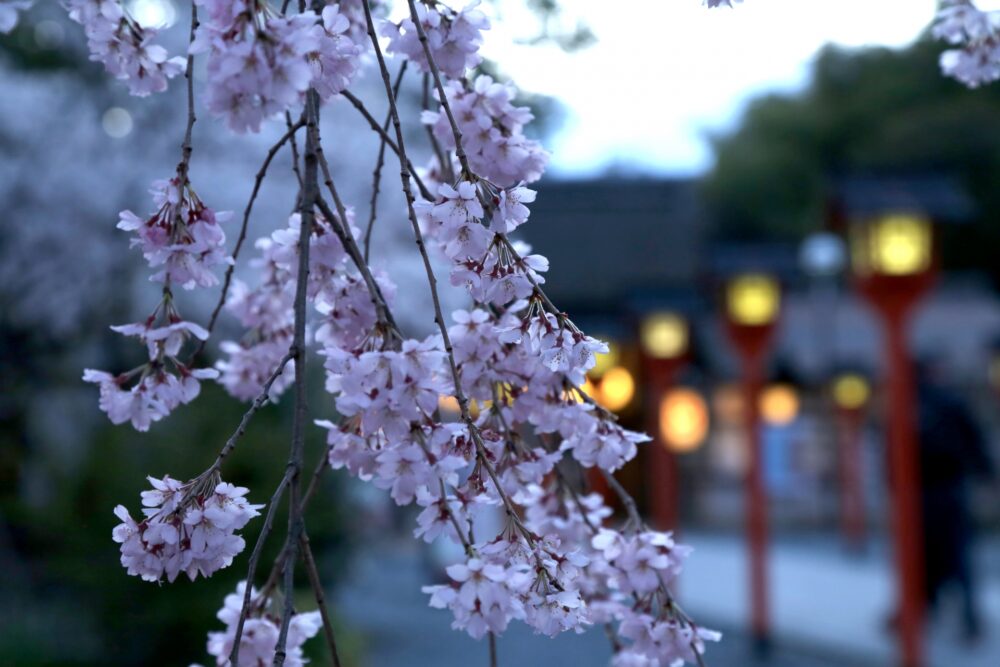
Hirano Shrine boasts a rich history dating back to its establishment in 782 within the Heijo Palace complex. In 794, the shrine was relocated to its current site, located in the northwest of Kyoto, following the capital relocation to Heian-kyo (modern Kyoto).
Emperor Kazan (968-1008) planted thousands of cherry trees in the shrine’s precincts, making it famous as a shrine of cherry blossoms. Even today, the shrine boasts over 400 cherry trees of 50 different varieties, attracting a large number of visitors during the cherry blossom season. The shrine also offers a light-up event, creating a mystical atmosphere in collaboration with the shrine buildings. The paid area is limited to the garden with a dense concentration of cherry trees, while the area from the entrance to the main hall is free of charge.
Tips to avoid crowds
- Visit on weekdays
the shrine is more crowded on weekends and holidays, as Japanese tourists also visit. - Visit late at night
the shrine’s light-up event runs from sunset to 9:00pm. The number of visitors starts to decrease around 8:00pm, one hour before closing time. You can still see the cherry blossoms around the shrine after it closes at 9pm. - Take public transportation
the roads are crowded during the cherry blossom season, and buses and taxis may not be on time. It is best to take the train and walk to the shrine. Take the Keifuku Arashiyama Line to Kitanohakubaicho Station. It is a 5-minute walk from the station to the shrine.
Information
Night illumination
Open hours
| Place | Time |
|---|---|
| The entrance to the main hall | Sunset to 9:00pm |
| Cherry blossom Garden | Sunset to 9:00pm |
Entrance Fee
| Place | Price |
|---|---|
| The entrance to the main hall | Free |
| Cherry blossom Garden | 500yen |
Day time(cherry blossom season)
Read more…
Open hours
| Place | Time |
|---|---|
| The entrance to the main hall | 6:00am to 5:00pm |
| Cherry blossom Garden | 8:00am to 5:00pm |
Entrance fee
| Place | Price |
|---|---|
| The entrance to the main hall | Free |
| Cherry blossom Garden | 500Yen |
Regular holiday
None
Address
〒603-8322 Kyoto, Kita Ward, Hirano Miyamotocho, 1
Official wbsite
Hirano jinjia Official site(English)
Daigoji temple
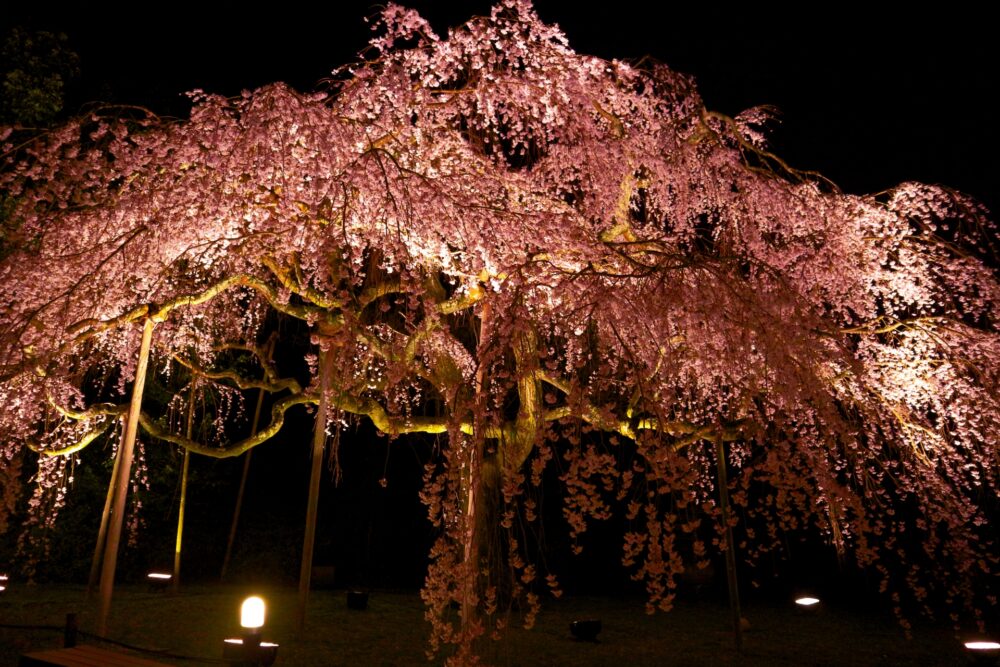
Daigoji Temple is located in the southeastern part of Kyoto and is the head temple of the Daigo school of Shingon Buddhism sect. With a long history of over 1100 years, the temple has a vast 6458ft²(600㎡) land area with many National Treasure buildings, such as the five-storied pagoda built in 951 and the Niomon Gate (a gate with two wooden statues of Nio, the temple’s guardian deities) built in 1605.
Daigoji Temple is famous for its cherry blossoms. Toyotomi Hideyoshi, who unified Japan for the first time, had cherry trees planted and designed the garden, wishing to “see cherry blossoms at Daigoji Temple.” As a result, there are about 700 cherry trees of various kinds, including weeping cherry trees, Somei Yoshino cherry trees, double cherry trees, and mountain cherry trees now.
The highlight is the Daigo Oshidarezakura, a weeping cherry blossom tree with a branch spread of over 65ft(20m). At night, this cherry tree is lit up, creating a breathtaking sight that leaves visitors speechless.
Tips to avoid crowds
The Daigoji Temple night will not be crowded inside the temple due to online reservation-only. illumination is reservation-only, it However, it can be crowded on the way there during the cherry blossom season.
It is better to go to the temple by trains and walk than by buses and taxies to get to the temple on time. The nearest station is Daigo Station on the Kyoto City Subway Tozai Line, and it is a 15-minute walk from the station.
Information
Special illumination (Online reservation only)
March 24th(Sun), 28th(Thu)
Click the link to get tickets(Only Japanese text):
https://souda-kyoto.jp/plan/spring_sp/index.html
Day time
Read more
Spring season
Open hours
9:00am to 5:00pm
| Places | Price |
|---|---|
| Sanbo-in garden, Reihokan Garden and Garan Area | Adult: 1,500yen junior high and high school student: 1,000yen |
| Reihokan Museum and Heiseikan museum | Age over junior high school student : 500yen |
Normal season
| Term | Open Hour |
|---|---|
| March.1st to December.1st | 9:00am to 5:00pm |
| December.2nd to February.28th | 9:00am to 4:30pm |
| Places | Price |
|---|---|
| Sanbo-in garden and Garan Area | Adults: 1,000yen junior high and high school students: 700yen |
| Sanbo-in garden or Garan Area | Adults: 600yen Junior high and high school students: 400yen |
| Sanbo-in special visiting | Age over junior high school students : 500yen |
| Reihokan Museum | Age over junior high school students : more than 500yen as a donation |
Adress
22 Daigohigashiojicho, Fushimi Ward, Kyoto, 601-1325
Official website
Daigoji temple(English text)
Byodo-in Temple
Byodo-in Temple, located in southern Kyoto, was built in 1052 by Fujiwara no Yorimichi. It is one of Japan’s most iconic temples, so much so that it is depicted on the tail of the 10-yen coin. The temple complex includes the Jodo Garden, the oldest Pure Land garden, which evokes the image of the Pure Land of Amida Buddha, and the Phoenix Hall, named for its resemblance to a phoenix spreading its wings. In 1994, it was registered as a UNESCO World Heritage Site for its cultural significance.
The Phoenix Hall is illuminated at night with a completely reservation-only system, and the vermilion Phoenix Hall shines fantastically. In the spring, the magical scenery of the hall with cherry blossoms is a popular photo spot.
Tips to avoid crowds
Byodoin Temple requires full reservations, so the grounds are not crowded with visitors. However, be aware that the approach to the temple can be crowded.
It is recommended to travel by train and on foot rather than by taxi or bus. There is no parking or bicycle parking available. From Kyoto Station, take the JR Nara Line to Uji Station, and from there it’s an 11-minute walk to Byodoin Temple.
Information
Night illumination(omplete reservation system)
Opening Hours
6:30 p.m. – 8:30 p.m. (Last admission 8:00 p.m.)
Entrance Fee
1,800yen
Here’s a Ticket Booking Website
![[Byodoin Temple] Exclusive Night-time Visit](https://www.seasonal-japanese-garden.com/wp-content/uploads/2024/02/Screenshot-2025-03-20-at-18.01.15-320x180.png)
Adress
Official Website
Byodo-in Temple(English Text)
